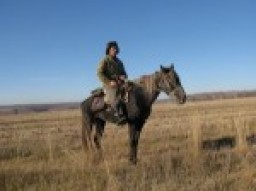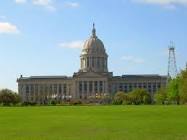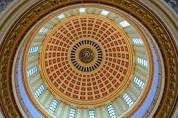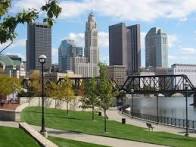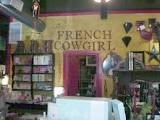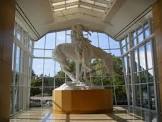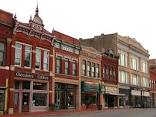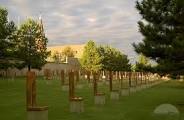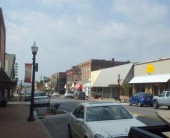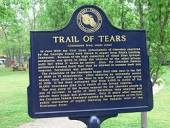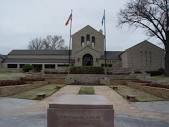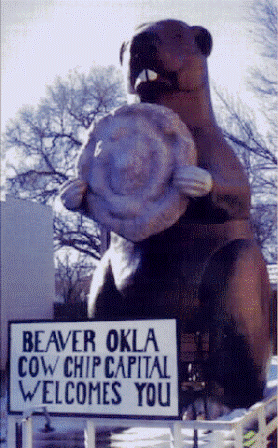The buckle on the Bible Belt polishes up just fine…
I spend a whole Sunday afternoon wandering the deserted streets of downtown Oklahoma City. Gazing up at the art deco facades that grace so many buildings in this wealthy cow town on the high plains, I realise that I haven’t seen a fellow pedestrian in an hour. Keen to speak to someone, anyone really, I return to my hotel and ask at the front desk, ‘Where is everyone?’
She checks her watch. ‘They’re all still at church.’
‘But it’s nearly five o’clock,’ I say exasperatedly.
‘Honey, this is not only the Bible Belt, it’s the buckle on the Bible Belt.’ This refrain I hear often in the coming weeks. Oklahomans take church and gridiron football very seriously, combined they represent the state’s inner soul.
‘There’s no echo in the capitol dome,’ adds my loquacious hotel receptionist apropos of nothing. I’m gradually getting used to hearing quirky non-sequiturs uttered with hand-on-heart sincerity since I arrived in Oklahoma, but this one registers from somewhere beyond left field.
‘Y’all just stand under that dome and yell and nothing comes back,’ she affirms.
A dome without an echo shouldn’t be missed. Luckily the capital precinct is on my itinerary of must-see sights in Oklahoma City and I’m there the next day.
It’s an impressive neo-classical building that also boasts its own oil well drilled under it; the echo of money making perhaps? Security to gain entry into the Capitol building consists of an x-ray scanner and a hulking State Trooper. This blue-eyed, black-haired tower of humanity stops me, ‘Where y’all from?’
‘I’m from far away, Australia actually. Where are you from?’
‘I’m from Beaver, out in the panhandle.’
‘What brings you to Oklahoma City?’ I ask.
‘I come here ‘bout once a month for the traffic police. In Beaver we get ‘bout four accidents a month, but here in Oklahoma City we get us ‘bout fourteen or fifteen a week!’ he exclaims looking like a very friendly Chesty Bond caricature in a police uniform.
‘So what happens in Beaver?’ I persist.
‘We got us a Cow Chip Tossing Contest every year in summer.’ Beaver’s stake in Oklahoma’s tourism business consists of manure throwing festivities and a giant beaver statue. I tick Beaver on my list of future must-see towns in mid-America.
By now I’ve led him to the rope barrier underneath the dome and begun to explain how I’ve heard that there is no echo and that without his approval I’ll likely be arrested if I cross the rope and yell up into the dome. I assume he won’t penalise me for disturbing the peace.
‘I can’t yell up the dome but you go right ahead and see,’ he offers permission.
I hop over the rope and yell. There is an echo after all but this is not the last I hear of Beaver during my stay in the Sooner State.
When I told friends that I was going to Oklahoma, each one asked, ‘Where’s it playing?’ I explain that I’m not seeing the famous Rodgers and Hammerstein musical revived for the umpteenth time but the actual 46th American state. I simply want to discover more about its present reality rather than the hoary old stereotype of winds rushing through the plain, surreys with fringes and sweet-smelling wheat.
This is cowboy country. Rodeos are wildly popular. Shopping here is dominated by Western gear: high-heeled cowboy boots, Stetson hats, silver buckles on wide cow leather belts proliferate. There’s even a boutique shop called French Cowgirl in OK City’s trendy Western Ave that sells cowboy chic. Even if Oklahomans claim to have never been on a horse, they at least look like they ride one every day. I’m told that there are more horses per capita here than in any other state and I believe it.
The National Cowboy & Western Heritage Museum in Oklahoma City is one of the country’s finest museums devoted to all things concerning pioneering American style. For a comprehensive overview of ‘how the West was won’ and its intricate history, this is the place to go. Typically for an American museum, commentaries are well written and researched. Kids are particularly well served at this museum with an abundance of displays devoted to young students.
Oklahoma’s tourism literature makes outrageous claims. The hyperbole strikes me as a cry for attention within a country of 49 competitors vying for ‘best in show’ but the facts and figures speak for themselves. OK is packed with geographical anomalies and historical oddities: eleven distinct eco-regions, (the most diverse in the USA per square mile), more shoreline than the Gulf and East coasts combined (lakes generously pepper the state), the longest stretch of Route 66, (the National Route 66 museum is in Elk City and Roger Miller’s “King of the Road” museum is in Erick ), the country’s first national wildlife park, (Wichita Mountains Wildlife Refuge), its largest contiguous historical district on the National Heritage Register (in Guthrie, the former state capital), Frank Lloyd Wright’s only skyscraper (the Price Tower in Bartlesville), the most American Indian tribal headquarters (the annual Red Earth festival is the country’s largest Indian celebration) and both North America’s oldest painted object (a 10,000 year old bison skull) and world’s largest dinosaur skull (a Pentaceratops) in the Sam Noble Oklahoma Museum of Natural History in Norman. Unsurprisingly, Oklahoma boasts the world’s largest cattle market. This is beef steak country after all. Surprisingly, by way of contrast, Oklahoma also has more than forty wineries.
Oklahoma also does a seriously intense trade in museums, monuments and memorials. They are almost innumerable.
In Oklahoma City’s National Memorial & Museum tears are welling when I listen to survivors’ stories recorded for posterity while they describe the horror of America’s worst terrorist attack prior to September 11, the bombing at the Alfred P. Murrah Federal Building on April 19, 1995. The somber landscaped grounds that constitute the memorial have become a sacred site since it was officially opened by President Bill Clinton on the fifth anniversary of the massacre that cost the state 168 innocent lives. The museum’s photograph gallery dedicated to the children killed in the day care center continues to haunt me. Indeed the entire complex of museum and memorial has a greater impact on me than I expected. I feel vulnerable and miserable at man’s inhumanity to man when I leave.
Native American Indian culture is ubiquitous in Oklahoma. The name itself derives from a duo of Choctaw words meaning ‘red people’. Designated ‘Indian Territory’ until 1907, more tribes call Oklahoma home than any other state. Since the relaxation of regulations regarding casinos operating on Native American lands, many tribes have struck it rich. Similarly, wildcat oil drillers did likewise in the 1920s and 30s. Oklahoma gained a poor reputation for hard times and desperate people of the ‘dust bowl’ best described in John Steinbeck’s masterpiece ‘The Grapes of Wrath’ but while exhausted farmers were escaping from eroded lands, entrepreneurs were making huge fortunes prospecting for black gold. The Phillips family established Phillips Petroleum in Tulsa and set high standards for artistic philanthropy when they opened the Philbrook Museum of Art and the Woolaroc wildlife reserve and Western American museum. The oil industry still contributes huge sums to the state’s tax coffers. While the oil wells have been pumped dry, the petroleum technology and support industries thrive.
Now Native Americans are plowing their casino revenues back into their communities through college scholarship programs, health care, aged care villages and numerous cultural centres. I visit the Citizen Potawatomi Nation Cultural Heritage Center in Shawnee to learn more about the Nishnabe ‘Original People’ nation comprising the Ojibwe and Odawa people as well as the Potawatomi. I’m told that Jim Thorpe, the word’s greatest athlete was a citizen Potawatomi and that the forced migration of the Nishnabe was called the ‘Trail of Death’ by its survivors, so many perished on the long march from the Great Lakes region to the sparse lands in central Oklahoma. The Potawatomi Casino provides the funds required to operate the Center and its community help projects.
At the Cherokee Nation Heritage Center and Tribal Complex in Tahlequah I discover that the Cherokee Casino contributes US$4 million to the concept of ‘Ga-du-gi’, a Cherokee word that describes “working together as a community in pursuit of a better quality of life for this and future generations” according to the Cherokee Nation’s mission statement.
A visit to The Cherokee Tribal Complex includes a recreated original tribal village. Defying a plausible description as ‘too tourist-y’, it delivers as close to an authentic pre-colonised Cherokee experience to the visitor as it’s possible to achieve and remain sincere from its educational vantage point. The museum compels its visitors to learn about the Cherokee Nation’s infamous ‘Trail of Tears’. During the 1840s thousands from the Five Civilized Tribes were marched from their ancestral eastern homelands and dumped out-of-sight, out-of-mind in lands occupied by foreign tribes.
The disastrous effects of the decimation linger in a resurgence of cultural pride obviously displayed at the various heritage centers located around the state. Native American people are reclaiming their history the way they want it to be told.
Days later my mood lifts at the Will Rogers Memorial outside Claremore. Arguably the state’s most famous native son, (Brad Pitt, Woody Guthrie, Ron Howard, Joan Crawford and Reba McEntire were also born in OK), Rogers was Hollywood’s best loved and highest paid performer until he died tragically in a plane crash in Alaska in 1935. His weekly column was read by 40 million fans and was syndicated in over 500 newspapers. It’s very easy to forget the lasting impression he made on contemporary language. Saying that, ‘I joked about every prominent man of my time but I never met a man, I didn’t like,’ he summed up his innately decent approach to life’s fellow travellers. His memorial is a key to understanding Oklahoma. Maybe I’m beginning to understand this state of contrasts finally.
Also in Claremore is the Lynn Riggs Memorial. Haven’t heard of him? Riggs wrote the play ‘Green Grow the Lilacs’ which was adapted by Rodgers and Hammerstein. ‘Oklahoma’, the musical was born. I realise that I’ve come full circle while I read Oklahoma’s title song lyrics at Riggs’ memorial.
Yes, the irony gene is noticeably absent in many Middle Americans. But when it’s apparent, take note or risk missing gems. On the road to Guthrie I tell my host about my conversation with the State Trooper from Beaver and he tells me that when his fellow tourism officials went to Beaver to offer its town council the opportunity to participate in a state celebration, they suggested that their fiberglass statue of a standing beaver should be displayed as a symbolic gesture. But they were discouraged by the fact that it hadn’t been painted in many years, was looking ‘poorly’ and they couldn’t afford to re-cover the giant beaver. The statue resides on a trailer and is positioned around the town as needed. They argued for some hours about the problem until one of the councilors, a silver haired lady of impeccable taste evidently, suggested that since they couldn’t afford paint that they might just polish the beaver with wax. ‘Let’s just wax the beaver,’ she insisted. My friend left the council chamber before he offended the civic minded Beaverians with his barely suppressed laughter.
Nearer the close of my visit to OK I tell the extended Beaver story to my host in Tahlequah. She laughs and tells me that down the road from Beaver is a town called Hooker. The two hamlets have rival football teams that compete in the annual regional contest and theirs is a fierce battle in gridiron football obsessed Oklahoma. One year Hooker narrowly beat Beaver in a season of hard fought games played in packed high school stadiums. The following day the town’s newspaper proudly proclaimed in its headline that: “Hooker Shaves Beaver!”
Oklahoma is one of those rare destinations where plain travel truths speak volumes of mystery.
Tom Neal Tacker travelled courtesy of United Airlines and Oklahoma Tourism.
Naked Facts:
Naked Routes:
United Airlines has direct flights to Oklahoma City and Tulsa from its hubs in Denver and Chicago. Oklahoma City is centrally located in the middle of the state. All major car rental companies operate there. See www.united.com
Naked Sleeps:
The Colcord Hotel is a restored heritage skyscraper in central Oklahoma City. Its restaurant, Flint, is also one of the city’s best. It’s a really lovely hotel with quite spacious rooms in a great central location. Rooms from USD$130.00. 15 N. Robinson, Oklahoma City, OK Phone: ( 1) 405 601 4300 or www.colcordhotel.com
Naked Tips:
www.TravelOK.com is the state’s official tourism website.
Oklahoma’s climate is temperate with extreme highs in mid-summer and lows in mid-winter though snowfall is fairly rare. During spring (April and May in particular) Oklahoma is regularly hit with quite violent thunderstorms that often result in extremely dangerous and highly destructive tornadoes. Travel may be interrupted for days at a time during the worst of the ‘tornado season’. Almost perfect weather usually occurs during autumn, September through late November.

